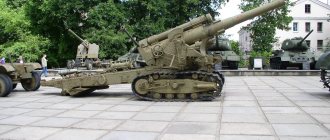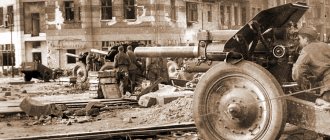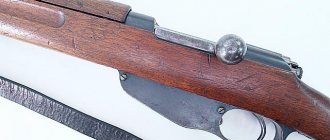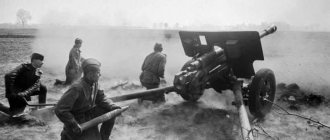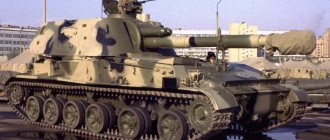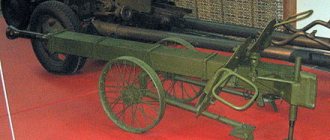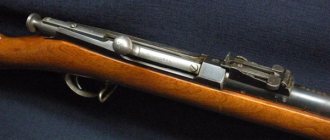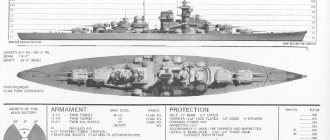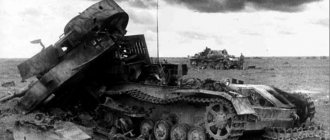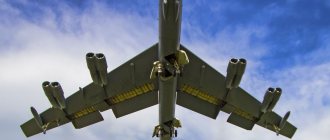| 152 mm gun-howitzer D-20 | |
| Type | towed howitzer gun |
| A country | USSR |
| Service history | |
| In service | and a number of others |
| Wars and conflicts | The Vietnam War, the Six-Day War (1967), the Yom Kippur War, the Afghan War (1979-1989) and several others |
| Production history | |
| Constructor | OKB-9 |
| Designed by | 1947 |
| Manufacturer | Motovilikha plants |
| Years of production | since 1953 |
| Options | 52-P-546, 52-P-546M, M-390 |
| Characteristics | |
| Weight, kg | 5650 |
| Tractor type | AT-L, Ural-375D |
| Ground clearance, mm | 380 |
| Carriage speed on the highway, km/h | up to 60 |
| Length, mm | 8690 |
| Barrel length, mm | 5195 (34 cl.) with muzzle brake |
| Width, mm | 2317 |
| Height, mm | 1925..2520 |
| Crew (crew), people. | 8 |
| Caliber, mm | 152 |
| Gate | Vertical semi-automatic wedge valve |
| Recoil device | hydraulic buffer and hydropneumatic recuperator |
| Carriage | with sliding frames |
| Elevation angle | from −5° to 45° |
| Angle of rotation | 58° |
| Rate of fire, rounds/min | 5-6 (peak) 1 (long-term) |
| Initial projectile speed, m/s | OFS: 511…655 : 600 BKS: 680 |
| Sighting range, m | 17 410 |
| Maximum range, m | 24,000 (ARS) |
| Aim | PG-1M and OP-4M |
| Media files on Wikimedia Commons | |
This article is about the 152 mm Soviet towed gun.
For the Soviet bypass turbojet engine, see D-20. 152 mm gun-howitzer D-20
(GRAU index -
52-P-546
) - Soviet 152-mm towed gun-howitzer with manual loading.
It first became known in the West in 1955, therefore in the countries of the NATO bloc - OTAN has the designation M1955
.
History[edit | edit code]
Back view.
The D-72 howitzer gun was developed immediately after the end of World War II at OKB-9 by F. F. Petrov; it was supposed to replace the pre-war 152-mm howitzer-gun ML-20 model 1937. Somewhere in 1950 - 1952, the howitzer was renamed the D-20 gun-howitzer (D is the factory index, 20 is a replacement for the ML-20), since the elevation angle was limited to 45°. The D-20 was the first 152 mm gun system with a semi-automatic wedge breech with vertical wedge movement. Also, this is a weapon in the D-22 modification (GRAU index - 2A33
) was used for self-propelled guns 2S3 or Akatsiya. Production began in 1953 at Plant No. 9. In 1955 it was moved to Plant No. 221.
Where can you see[edit]
Due to the relatively small number of guns fired and their less frequent capture by the enemy, D-1 howitzers are somewhat less common in military museums than other types of guns. The howitzer can be seen in Moscow in the Central Museum of the Armed Forces, in front of the main entrance to the museum. In St. Petersburg it is exhibited in the Museum of Artillery and Engineering Troops, in Saratov - in the Saratov State Museum of Military Glory in Victory Park, in Sevastopol - in the Museum of Heroic Defense and Liberation of Sevastopol on Sapun Mountain (the Sevastopol exhibit was made in March 1946, to On June 29, 1959, the howitzer fired 153 shots), in Kiev - in the Museum of the Great Patriotic War, in Tolyatti - in the Technical Museum, in Verkhnyaya Pyshma (Sverdlovsk Region) - in the Museum of the "Military Glory of the Urals", in Astana - in the Museum of the Armed Forces of the Republic of Kazakhstan. Memorial D-1 howitzers are also located in the Belarusian Polotsk and the Poznan Citadel in Poland; in Volgograd, this weapon is included in the exhibition of the Panorama Museum “Battle of Stalingrad”. Another howitzer is installed on a pedestal at the Kursk Bulge Memorial Complex in Kursk. Also, two howitzers in excellent condition can be viewed in the village. Khotkovo, Duminichsky district, Kaluga region. One D-1 howitzer stands in the village of Cherepanovo, Novosibirsk region.
Modifications[edit | edit code]
The D-20 is in service in at least 13 countries and was produced under license in China as the Type 66
(or the modernized
Type 66-1
).
The self-propelled gun based on it, known as the Type 83
, was first introduced in the mid-1980s.
Yugoslavia also manufactured the M84 NORA-A gun-howitzer, developed on the basis of the D-20, and Serbia, based on the 155-mm modification of the M84 NORA-A,
the Nora B-52 self-propelled gun on a four-axle wheeled chassis
FAP-2632
.
Russia[edit | edit code]
D-20M
or
“Khitin”
(GAU Index -
52-P-546M
) - a modernized version, equipped with an automatic rammer, increasing the rate of fire to 7-8 rounds/min. The modernization was carried out by the Titan Central Design Bureau. Offered for export.
China[edit | edit code]
- Type 66 (English)Russian - Chinese version of the D-20 produced under license. The modernized version is known as Type 66-1
.[1] Type 83 is a self-propelled artillery unit created on the basis of artillery pieces from the
Type 66
, and is identical in design to the 2S3 Akatsiya self-propelled gun.
Romania[edit | edit code]
- The A411
is a howitzer developed by
Arsenal Armatei
, basically similar to the D-20.
This option uses its own 152-mm ammunition, which (with a barrel length of 20.5 calibers) has a maximum range of 17.2 km (24 km with the OF-550 projectile). In the Romanian army, the A411
is known as the
152-mm towed gun-howitzer M1981
(Romanian: Tun/Obuzier calibrul 152-mm tractat M1981).[1]
Also, Romania produced the 130 mm A412
(based on the artillery unit of the 130-mm Chinese version of the D-74 gun
type 59-1
) known under the designation
M1982
(or
M82
) and the 152-mm
A425
(based on Chinese technology) known under the designation
M1985
(or
M85
), in which a carriage was used from duplex D-74/D-20.[1]
Design description[edit]
The D-1 howitzer was a very advanced weapon for its time. The gun barrel, almost identical to the barrel of the M-10 howitzer, was equipped with a DT-3 two-chamber muzzle brake. The main design features of the D-1 howitzer barrel group include variable recoil length, a piston-type bolt, a hydraulic recoil brake and a hydropneumatic knurler. Loading is separate cartridge case; in total, 8 different propellant charges were provided for the gun.
The gun carriage is almost identical to the M-30 howitzer carriage. The frames on the guns of the first series were riveted, then they began to be welded. Later series guns were additionally equipped with rollers for manual rolling. All D-1 howitzers were equipped with steel wheels with rubber pneumatic tires, and the wheel travel was equipped with suspension. The gun did not have a limber; transportation was carried out exclusively by mechanical traction. The permissible speed for transporting a gun on asphalt or a flat dirt road was up to 40 km/h, on cobblestones - up to 30 km/h, and off-road - up to 10 km/h. To protect the crew from bullets and small fragments, the D-1 howitzer had a shield cover.
Operators[edit | edit code]
Modern operators[edit | edit code]
- Azerbaijan - 24 D-20, as of 2020[9]
- Angola - 4 D-20, as of 2020[10]. delivered in 1999 from Bulgaria[11]
- Armenia - 34 D-20, as of 2020[12]. 87 D-20 units as of 2020[13]
- Bulgaria - 24 D-20, as of 2020[14]
- Hungary - 18 D-20, as of 2020[15]
- Vietnam - a number of D-20, as of 2017[16]
- Iraq - a number of D-20s, as of 2017[17]
- Iran - 30 D-20, as of 2020[18]
- China - some (<2106) Type 66
(D-20), as of 2020[19] - Republic of the Congo - a number of D-20, as of 2018[20]
- Moldova - 31 D-20, as of 2020[21]
- Nicaragua - 30 D-20 in storage, as of 2017[22]
- NKR - 50 D-20, as of 2020[23]
- Syria - a number of D-20, as of 2017[24]
- Turkmenistan - 72 D-20, as of 2020[25]
- Ukraine - >130 D-20, as of 2020[26]
- Sri Lanka - 46 Type 66
(D-20), as of 2020[27]
Other operators[edit | edit code]
- Peshmerga - some D-20, as of 2017[28]
Former operators[edit | edit code]
- Albania - Chinese Type 66
were in service as of 1991-1992[29] - Afghanistan - D-20 were in service as of 2004-2005[30]
- Belarus - 58 D-20 units as of 2010[31]
- Bosnia and Herzegovina - a total of 30 guns, including 13 D-20 and 17 M84 "NORA-A"
as of 2010[32] - GDR - see data for Finland
- Yemen - 10 D-20 units as of 2010[33]
- Kazakhstan - 74 D-20 units were in service as of 2007[34]
- DPRK - a significant number of Chinese Type 66
were in service as of 1991-1992[35] - Myanmar - 35 units delivered in 2009 from the DPRK
- NKR - 53 D-20 guns were in service as of 2004-2005[36]
- Poland - 166 D-20 were in service as of 1991-1992[37]
- Romania - 84 D-20s were in service as of 1991-1992[38], as of 2010 the Romanian Army had 329 M1981
(245 were in service)[39] - Russia - 1075 D-20 units in storage as of 2016[40]
- Serbia - a total of 68 guns, including 18 D-20 and 50 M84 "NORA-A"
were in service as of 2007[41] - USSR - passed to the former republics of the USSR
- Finland - Former East German guns, known in Finland as 152 H 55
were in service as of 2004-2005[42] - Croatia - a total of 41 guns, including 20 D-20, 18 M84 "NORA-A"
and 3 M84H as of 2010[43] - Yugoslavia - M84 "NORA-A"
(passed to successor countries)
D-1 abroad
The D-1 howitzer was sold or transferred to a large number of countries around the world. It is still in service with the armies of some CIS countries, as well as the armed forces of China, Afghanistan, Iraq, Hungary, Mozambique, Syria, Vietnam, Cuba, Albania and a number of other states. The distribution of this howitzer was even more widespread in the recent past, when it was in service with member states of the Warsaw Pact, for example, Poland. The weapon was used in combat in the Arab-Israeli wars, as well as in conflicts on the territory of the former USSR [ source not specified 561 days
].
Notes[edit | edit code]
- ↑ 123
Janes Armor and Artillery 2003—2004 - ↑ 1234
At the Motovilikha Museum, the replenishment of the site with military equipment has begun (Russian). JSC "Motovilikha Plants" Retrieved May 10, 2012. - Bulgaria donated howitzers to Iraq to fight ISIS (unspecified)
. Lenta.ru (January 15, 2015). Retrieved December 7, 2020. - Military equipment in Chechnya (1999-2000) (unspecified)
. Air Defense Bulletin. Retrieved December 7, 2020. - "Heirs of Shah Ismail." Armies of the countries of the former USSR: Azerbaijan (undefined)
. Lenta.ru (January 11, 2014). Retrieved December 15, 2020. - Karabakh flared up again (undefined)
. Gazeta.Ru (April 2, 2016). Retrieved April 26, 2020. - Report of the OSCE SMM in Ukraine for May 16, 2020 (unspecified)
. OSCE (17 May 2016). Retrieved May 20, 2020. - Report of the OSCE SMM in Ukraine for May 15, 2020 (unspecified)
. OSCE (16 May 2016). Retrieved May 20, 2020. - The Military Balance 2020. - P. 201.
- The Military Balance 2020. - P. 495.
- Jane's Armor and Artillery 2002-2003 / edited by Christopher F. Foss. — 23rd edition. - Jane's Information Group, 2002. - 952 p. — ISBN 978-0710624253.
- The Military Balance 2020. - P. 199.
- International Institute for Strategic Studies.
The Military Balance 2020 / James Hackett. - London: Taylor&Francis, 2020. - P. 178. - 504 p. — ISBN ISBN 9781857438352. - The Military Balance 2020. - P. 97.
- The Military Balance 2020. - P. 124.
- The Military Balance 2020. - P. 339.
- The Military Balance 2020. - P. 381.
- The Military Balance 2020. - P. 377.
- The Military Balance 2020. - P. 280.
- The Military Balance 2020. - P. 455.
- The Military Balance 2020. - P. 209.
- The Military Balance 2020. - P. 464.
- https://vpk-news.ru/articles/29587
- The Military Balance 2020. - P. 405.
- The Military Balance 2020. - P. 226.
- The Military Balance 2020. - P. 228.
- The Military Balance 2020. - P. 330.
- The Military Balance 2020. - P. 563.
- The Military Balance 1991-1992. - P. 83.
- The Military Balance 2004-2005. — P. 149.
- The Military Balance 2010. - P. 178.
- The Military Balance 2010. - P. 179.
- The Military Balance 2010. - P. 277.
- The Military Balance 2007. - P. 319.
- The Military Balance 1991-1992. - P. 168.
- The Military Balance 2004-2005. - P. 82.
- The Military Balance 1991-1992. - P. 91.
- The Military Balance 1991-1992. - P. 92.
- The Military Balance 2010. - P. 157.
- International Institute for Strategic Studies.
The Military Balance 2020 / James Hackett. - London: Taylor&Francis, 2020. - P. 190. - 504 p. — ISBN ISBN 9781857438352. - The Military Balance 2007. - P. 172.
- The Military Balance 2004-2005. - P. 87.
- The Military Balance 2010. - P. 124.
- Ruzaev S.V.
Artillery systems from the collection of the UMMC Museum of Military Equipment. — Ekaterinburg: Uralsky Rabochiy, 2020. — 80 p. — 1000 copies. — ISBN 978-5-85383-687-7.
Howitzer D-1 – video
https://youtube.com/watch?v=nbsqfByhLY8
The double-frame carriage, shield and recoil mechanism of the 122 mm M-30 howitzer were combined with the barrel of the 152 mm M-10 howitzer (model 1938), which made it possible to use the M-10 family of ammunition with variable propellant power. Where necessary, the M-30's chassis was reinforced to withstand the additional load.
The result was a howitzer of a very successful design, almost 1000 kg lighter than the excessively heavy 152-mm M-10 howitzer, which the D-1 replaced at several artillery factories. The lighter D-1 is easier to handle, but it retains the same maximum firing range (12,400 meters) and penetration power as its prototype. Moreover, the D-1 turned out to be so successful that it is still in service with the armies of the CIS countries and former members of the Warsaw Pact, although it is mainly used for training purposes and is in reserve, and is also widely used in other countries, in including in China (which produces an almost completely identical modification of the 152 mm Type 54). Iraq, Cuba and Egypt (among others).
The main type of D-1 ammunition used is a highly effective 40 kg high-explosive fragmentation shell containing almost 6 kg of TNT, although other types of ammunition have been developed over the years, including smoke grenades and chemical shells filled with lewisite (now are not used). Other types of ammunition include special concrete-piercing ones, used for the destruction of defensive structures and during combat operations in urban settlements, as well as anti-tank cumulative, currently withdrawn from service everywhere except Romania, where a cumulative projectile with a stabilizing agent is still produced plumage of our own design.
Combat use
D-1 howitzers were actively used at the final stage of the war, in 1944-1945. The gun was used for firing from closed positions at the enemy's dug-in and openly located manpower, his fortifications and obstacles, for counter-battery combat and the destruction of important objects in the enemy's near rear. To destroy enemy tanks and self-propelled guns in self-defense, a concrete-piercing projectile was successfully used. Among artillerymen, the D-1 gained a reputation as a reliable and accurate weapon when firing.
Project evaluation
The D-1 howitzer, at a minimum, was not inferior in its characteristics to the best world models of guns of this class. It fully satisfied the requirements of the Red Army in terms of mobility, power and firing range. The wide distribution of the D-1 throughout the countries of the world and its long service in their national armies serve as sufficient confirmation of this.
For comparison, the most popular German 15 cm heavy field howitzer sFH18 had a maximum firing range of 13,325 m, surpassing the D-1 by almost a kilometer; but at the same time it was almost 2 tons heavier (travel weight 5510 kg), which greatly limited mobility. The Germans failed to put the more advanced sFH36 howitzer, which has excellent characteristics (firing range 12,500 m, weight in the stowed position 3,500 kg), into large-scale production. The Czech 150-mm howitzer Škoda K4 (German name sFH37(t)) had a firing range of 15,750 m and a mass of 5,730 kg, significantly superior to the D-1 in terms of firing range, but at the same time greatly inferior in mobility (this weapon is closer to powerful howitzers - guns). The same can be said about the Italian 150-mm howitzer model 1937 (Italian: Obice da 149/19 modello 37) (14,250 m, 5,500 kg) and the American 155-mm howitzer M114 (14,600 m, 5,800 kg). French 155-mm howitzers Schneider mod. 1917 (French Canon de 155 C modèle 1917 Schneider) were inferior to the D-1 both in firing range (11,200 m) and in weight (4300 kg), and by the beginning of World War II they were clearly outdated, like the British 6- Vickers inch howitzers (BL 6-inch 26 cwt howitzer), created in 1915.
Literature[edit | edit code]
- 152-mm gun-howitzer D-20. Service manual. — Third edition. - M.: Military Publishing House of the USSR Ministry of Defense, 1981. - P. 243. - 301 p.
- D-74 cannon and D-20 howitzer gun. Service management / engineer-colonel Chernov V.P. - M.: Military publishing house of the USSR Ministry of Defense, 1958. - 356 p.
- Shirokorad, A. B.
Encyclopedia of domestic artillery / Under the general editorship. A.E. Taras. - Minsk: Harvest, 2000. - 1156 p. — (Library of Military History). — ISBN 985-433-703-0.
Interesting facts about D-1
- Like other 152 mm guns, the work of the loader and carrier in the crew was very difficult - it was necessary to carry shells weighing over 40 kg alone.
- The 53-OF-530 shells, which were developed in the late 1930s and used by the D-1 howitzer, are suitable for firing from more modern howitzers in service with the Russian Army.
- The method of manufacturing concrete-piercing shells for the D-1 howitzer influenced their combat characteristics: the 53-G-530Sh shell could be fired at full (the most powerful) charge, but the 53-G-530 shell was strictly prohibited, in order to avoid its rupture in the barrel guns. The maximum charge allowed for the 53-G-530 was the first one; accordingly, its initial speed and depth of penetration into the concrete were less than those of the 53-G-530Sh.
- Unlike many other types of guns, the Finnish army, apparently, did not manage to capture a single serviceable D-1 howitzer - there is no D-1 howitzer in the rich exhibition of the Finnish artillery museum in Hämeenlinna.
152 mm howitzer model 1943 (D-1)
152-mm howitzer model 1943 (D-1, GAU Index - 52-G-536A) - Soviet howitzer during the Second World War. This gun was mass-produced from 1943 to 1949.
, was or is still in service with the armies of many countries around the world, and was used in almost all significant wars and armed conflicts of the mid and late 20th century.
The adoption of the mobile and powerful D-1 howitzer in 1943 increased the capabilities of tank and motorized units of the Workers 'and Peasants' Red Army (RKKA) to break through well-fortified enemy defensive zones and areas in advance.
History of creation
In 1941, for a number of reasons, serial production of 152-mm howitzers of the 1938 model (M-10) was stopped. According to the famous Russian historian M. Svirin, these included: A shortage of powerful tractors capable of effectively towing the M-10; High metal consumption and complexity in the production of the carriage; Difficulty in repairing and maintaining the weapon;
Factories No. 9 and 172 were busy with mobilization tasks for the mass production of other guns - M-30 howitzers and ML-20 howitzer guns, loss of factory No. 352; as a result, there was nowhere to produce the M-10.
One of the reasons for the cessation of production of the M-10 could also be the abolition of the corps unit in the Red Army in 1941 (most of the rifle corps were disbanded in August-September 1941) and, as a consequence, the corps artillery.
However, in the same year, rifle corps began to be formed again in the USSR and, accordingly, the corps level of the organizational structure of artillery was reintroduced. The excellent howitzer-cannon ML-20 was not suitable for corps artillery due to its large mass (i.e.
low mobility and fairly high cost), and the divisional 122-mm howitzer M-30 - due to insufficient firepower.
Therefore, at the end of 1942, the design bureau of the famous Soviet designer F. F. Petrov began to proactively design a new 152-mm howitzer, which was an overlay of the barrel group of the 152-mm howitzer mod. 1938 (M-10) on the carriage of a 122-mm howitzer mod. 1938 (M-30).
This approach made it possible to create a light but powerful howitzer using components already mastered in production, which was important in wartime conditions. https://www.youtube.com/embed/S1BxNYMVVuI
At the beginning of 1943, F. F. Petrov notified the People's Commissar of Armaments D. F. Ustinov about the new project. On April 13, 1943, D. F. Ustinov informed F. F. Petrov about the decision of the State Defense Committee (GKO) to supply 5 copies of the new howitzer by May 1, 1943 for field testing.
On May 5, two howitzers entered testing, which were completed within two days. On May 7, based on the test results, a report was signed in which the gun, after eliminating a number of minor deficiencies, was recommended for adoption.
By decree of the State Defense Committee of August 8, 1943, the gun was put into service under the official name “152-mm howitzer mod. 1943." Serial production began a month and a half later.
PRODUCTION
Production D-1, pcs. Year 1943 1944 1945 1946 1947 1948 1949 Total Manufactured, pcs. 84 258 715 1050 240 240 240 2827 Ammunition nomenclature Type GAU Index Projectile weight, kg Explosive weight, kg Initial speed, m/s Table range, m Caliber armor-piercing shells Marine semi-armor-piercing mod. 1915/28
51.07 3.2 ? ? HEAT shells HEAT 53-BP-540 27.44 ? 560 3000 Concrete-piercing shells Concrete-piercing long-range howitzer (with index Ш - filled with TNT using the auger method) 53-G-530 (53-G-530Sh) 40.0 5.1 508 (full charge) 12400 High-explosive fragmentation shells Steel long-range grenade 53- OF-530 40.0 5.47-6.86 508 (full charge) 12400 Steel cast iron long-range fragmentation grenade 53-O-530A 40.0 5.66 508 (full charge) 12400 Old grenade 53-F-533 40, 41 8.0 ? ? Old grenade 53-F-533K 40.68 7.3 ? ? Old grenade 53-F-533N 41.0 7.3 ? ? Old grenade 53-F-533U 40.8 8.8 ? ? Steel cast iron old French grenade 53-F-534F 41.1 3.9 ? ? Grenade from a 152 mm mortar mod. 1931 53-F-521 41.7 7.7 ? ? Steel English grenade for the 152-mm Vickers howitzer 53-F-531 44.91 5.7 ? ? Shrapnel Shrapnel with tube 45 sec. 53-Sh-501 41.16-41.83 0.5 (680-690 bullets) ? ? Shrapnel with tube T-6 53-Sh-501T 41.16 0.5 (680-690 bullets) ? ? Illumination shells Parachute illumination, burning time 40 sec. 3С1 40.2 ? ? ? Chemical shells Chemical howitzer 53-ХС-530 38.8? ? ? Chemical howitzer 53-ХН-530 39.1 ? ? ?
Chemical (adopted into service after the Great Patriotic War) 3X3? ? ? ?
203-mm self-propelled artillery mount 2S7 "Pion"
On May 1, 1957, at the parade in Moscow, heavy self-propelled guns were shown: a 406-mm artillery gun 2AZ “Kondensator-2P” (64 tons) and a 420-mm mortar 2B1 “Oka” (55 tons). Both products were extremely bulky (length - 20 meters, width - about 3 meters, height - about 6 meters) and heavy, but the weight and dimensions of the installations were actually set by nuclear scientists, who believed that the diameter of a tactical atomic projectile should be at least 400 mm. They produced only 4 copies, but the main thing is that the industry gained experience in creating artillery systems capable of firing nuclear tactical ammunition over long distances. By 1960, their development was stopped, giving preference to solving the problem of delivering a nuclear charge using tactical missile systems (For example:). Meanwhile, tactical missiles did not yet have homing systems, so their accuracy at maximum range was unsatisfactory.
It must be said that several years before this May Day parade, on May 25, 1953, the United States had already tested a system of a similar purpose at a nuclear test site in Nevada, consisting of a towed 280-mm T131 cannon (after the adoption of the M65, nicknamed “Atomic Annie” by the troops ” and a 280-mm Atomic Mk.9 (T124) Shell artillery projectile with a W9 nuclear warhead with a yield of 15-20 kT. The projectile was launched from the M65 cannon (weighing 77 tons) at a specified 32 km and successfully detonated. As with the Soviet 2A3 cannon, the American gun was bulky and unsuitable for combat. Only 20 guns were produced, which did not serve long in Western Europe. But already in 1963, the United States adopted a 155-mm projectile for self-propelled howitzers M114, M109, etc. The projectile was equipped with a W48 nuclear charge with a capacity of 72 tons of TNT (Mod 1 modification) and had outstanding weight and dimensions characteristics: length 33.3 inches, weight 128 pounds (51.2 kg). A year later, in 1964, a projectile with a W33 nuclear charge with a power of 10 kt, a length of 4.5 calibers and a weight of 110 kg was adopted for the 203-mm M110 self-propelled howitzer.
In 1964, N.S. Khrushchev resigned from the post of General Secretary of the CPSU Central Committee with his manic passion for solving all issues with the help of rocket technology. At the same time, technological readiness was achieved in the USSR: scientists achieved a reduction in the critical diameter of atomic weapons. Frankly speaking, the work that was frozen under Khrushchev only suggested the evolution of self-propelled guns that were put into service during the Great Patriotic War (for example, ISU-152 to ISU-152K, etc.). By this time, it became obvious that the USSR was significantly lagging behind the United States in self-propelled artillery and in the creation of small-caliber nuclear charges for conventional guns, i.e. in providing army units with tactical atomic weapons. To eliminate this backlog, development work began in December 1967 to create a heavy self-propelled artillery mount. Initially, neither the type of gun nor even its caliber was specified. Only the firing range was determined - 25 km. As a result, a decision was made to develop an open self-propelled gun with a high-power cannon (firing range with a conventional projectile is 32 km, and with an active-missile projectile - 45 km). On July 8, 1970, Resolution of the Central Committee of the CPSU and the Council of Ministers of the USSR No. 427/161 was issued, which began the development of a self-propelled gun, designated 2S7 and named “Pion.” The Leningrad Kirov plant was appointed the main developer and executor; the swinging part was manufactured by the Volgograd plant “Barricades” according to the design of the Central Design Bureau “Titan”.
